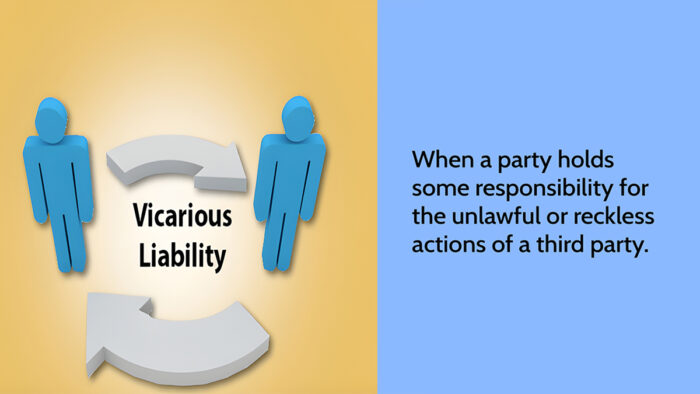Vicarious liability in insurance is a legal principle that holds one party responsible for the action of another party. This means that an employer or agent is acting on behalf of the employees, contractors, agents, partners, and volunteers and will bear responsibility for any harm caused by your employees or agents, even if they didn’t indirectly cause it.

Businesses should consider vicarious liability when assessing insurance policies because it’s crucial to ensure they understand the potential risks associated with employing staff, engaging contractors, or utilizing. These policies aim to protect businesses from the cost of lawsuits caused by vicarious liability claims and minimize the burden on the business.
How Vicarious Liability Works
Whoever represents the organization, such as employees, contractors, agents, or partners, will bear the responsibility for their unlawful actions. The represented party might also incur responsibility for careless harm and property damage.
For example, if an employee causes an incident while working, then the company the employee works for will be the one to face vicarious liability for any damages. Likewise, if a construction worker causes an incident by hitting a wall of a nearby building, then the company in charge of the construction may face vicarious liability.
Vicarious liability insurance holds employers responsible for the actions caused by their employees, contractors, agents, and partners because:
- The actions occur within the scope of their representation or employment.
- They have the ability to direct or control their work actions.
- They are found negligent in their hiring, training, and supervision.
By understanding how vicarious liability insurance works, businesses should make sure they have the right coverage to protect themselves against unexpected events.
What Does Vicarious Liability Insurance Cover?
Vicarious liability insurance covers things such as legal costs, settlements, and judgments if you’re sued due to an incident or actions caused by your workers, including;
- Agents
- Contractors
- Directors and officers
- Employees
- Partners
Problems covered by vicarious liability insurance are dependent on the type of business insurance purchased. This includes general liability insurance, which covers damage claims, and employment practices liability insurance, which handles discrimination claims.
Below are some examples of vicarious liability claims:
Vicarious liability insurance is an important part of insurance for businesses, as it helps protect them from the actions of others. These are some examples of vicarious liability claims:
- Bodily injuries
- Harassment
- Property damage
- Copyright infringement
- Discrimination
- Slander or libel
- Bullying
Each claim depends on the situation, but businesses should always consult with an insurance agent to make sure they have the right coverage in place.
What Does Vicarious Liability Insurance Not Cover?
Vicarious liability insurance typically covers a wide range of scenarios where one party is held responsible for the actions of another. However, there are certain situations and liabilities that may not be covered by vicarious liability insurance policies. Here are some examples:
- Intentional Acts
- Criminal Acts
- Contractual Liabilities
- Professional errors or omissions
- Liabilities beyond the scope of employment
- Unapproved Activities
- Liabilities in Certain Industries
It’s essential for insured parties to carefully review their insurance policies and understand the specific exclusions and limitations that may apply to vicarious liability coverage. Depending on their risk exposure and business activities, they may need to consider additional insurance coverage or risk management strategies to address any gaps in coverage.
Do I Need Vicarious Liability Insurance?
Determining whether one needs vicarious liability insurance is dependent on the nature of the business and the risks it faces. If you employ staff, contactors, agents, partners, or volunteers, then you will need vicarious liability coverage. That’s because it is exposed to the risk of vicarious liability lawsuits. Without business insurance, your company could face huge financial consequences.
For example, if your employee harms someone, your business will bear responsibility for any damages incurred. Vicarious liability insurance will protect your business from the burden of financial lawsuits arising from the actions of your representative. This includes legal costs, settlements, and judgments if you’re sued by the actions caused by your employees, agents, or contractors.
What Coverage Types Include Vicarious Liability Insurance?
It is important to make sure that your insurance policy covers the specific risks associated with your business.
- General liability insurance: It covers things such as legal costs, settlements, and judgments arising from injuries and property damage caused by a worker.
- Employment practices liability [EPLI]: It handles legal costs and settlement for vicarious liability claims that have to do with employment harassment, discrimination, and wrongful termination.
- Director and Office Insurance [D&O]: It covers claims against misrepresentation of company assets, copyright infringements, and theft of intellectual property.
- Workers compensation insurance: It covers medical bills, lost wages, and disability benefits for employees who suffer injuries while working.
- Errors and omissions insurance: It covers businesses and individuals against claims such as mistakes, negligence, or inadequate work.
Vicarious liability insurance is an important type of insurance for businesses to have.
How Much Does Vicarious Liability Cost?
The cost of vicarious liability coverage varies depending on the type of policy, business size, and level of coverage required.
- The median cost per month for general liability insurance is $42. But the actual cost of vicarious liability coverage will vary depending on various factors, such as the type of policy, the size of the business, and the level of coverage required.
- The median cost per month for errors and omissions insurance is $59. But the cost is dependent on the industry, the level of coverage required, and the risk associated with the business.
- The median cost per month for employment practices liability insurance is $182. But cost varies based on several factors. This includes the provider, locations, limits, coverage, number of employees, industry, and employment policies.
- The median cost per month for directors and officers insurance is $103. Costs vary depending on factors such as the company’s revenue, industry, location, and the number of directors and officers to be covered.
- The median cost per month for workers compensation insurance is $45. Costs depend on the state, number of employees, industry, and company’s loss experience.
With this, you already have a clear understanding of how the insurance charges and the way they charge.
How to protect your business from vicarious liability lawsuits
To safeguard your business from vicarious liability lawsuits, it is important to secure adequate insurance, such as general liability insurance, professional liability insurance, workers compensation insurance, and employment practices, to fight off vicarious liability claims.
FAQs
Who can be held vicariously liable for insurance?
In insurance, the insured party, such as a business or individual, can be held vicariously liable for the actions of their employees, agents, or anyone acting on their behalf.
Can vicarious liability claims impact premiums?
Yes, vicarious liability claims can impact premiums. If an insured party is found liable for the actions of a third party, it may lead to increased insurance premiums as the insurer perceives a higher risk associated with the insured’s operations.
How can insured parties mitigate vicarious liability risks?
Insured parties can mitigate vicarious liability risks by implementing risk management strategies, such as thorough employee training programs, conducting background checks on agents and contractors, maintaining proper documentation of contracts and agreements, and securing adequate insurance coverage.
What should insured parties do if faced with a vicarious liability claim?
If faced with a vicarious liability claim, insured parties should promptly notify their insurance company and cooperate fully with any investigations. It’s essential to provide all relevant information and documentation to the insurer to facilitate the claims process.
Is vicarious liability the same as primary liability in insurance?
No, vicarious liability is not the same as primary liability in insurance. Primary liability refers to the direct legal responsibility of a party for their own actions or negligence, while vicarious liability involves being held liable for the actions of another party.
Can businesses be held vicariously liable for the actions of independent contractors?
Yes, in some cases, businesses can be held vicariously liable for the actions of independent contractors, especially if the contractor is performing tasks within the scope of the business’s operations or under their direction and control. However, the specific circumstances of the relationship between the business and the contractor will determine liability.



